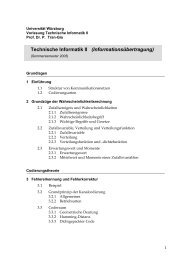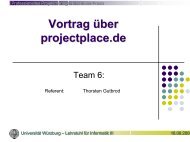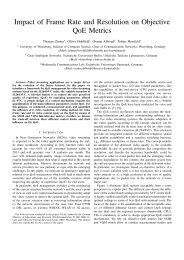Measurement and Analysis of Skype VoIP Traffic in 3G UMTS Systems
Measurement and Analysis of Skype VoIP Traffic in 3G UMTS Systems
Measurement and Analysis of Skype VoIP Traffic in 3G UMTS Systems
Create successful ePaper yourself
Turn your PDF publications into a flip-book with our unique Google optimized e-Paper software.
1CDF0.80.60.40.2<strong>in</strong>terarrival times<strong>of</strong> sent packets<strong>in</strong>terarrival times<strong>of</strong> received packetspayload observed <strong>in</strong>terarrival[Byte] packets timesender 3 3 20.05 ssender 67 1888 30.00 msrcver 3 3 20.25 srcver 67 1039 54.43 ms00 200 400 600packet <strong>in</strong>terarrival time [ms]Figure 9: S<strong>in</strong>gle run with 16 kbps bottleneck <strong>and</strong> 8000 bit buffer <strong>in</strong> the routerpackets. At first glance, the CDF <strong>of</strong> the receiver has a very unexpected shape. About 90 percent<strong>of</strong> all packets have an <strong>in</strong>terarrival time <strong>of</strong> practically 0ms, while the time between the rema<strong>in</strong><strong>in</strong>gpackets is about 500ms. The buffer <strong>in</strong> the router was set to 8000 Bit, while simultaneouslylimit<strong>in</strong>g the speed <strong>of</strong> the l<strong>in</strong>k to 16 kbps. <strong>Skype</strong> used a total packet size <strong>of</strong> 872 Bit. Thus, atmost 9 packets (872*9= 7848 Bit) fit <strong>in</strong>to the buffer <strong>of</strong> the router. To emulate a l<strong>in</strong>k speed <strong>of</strong>16 kbps, the router fills its buffer <strong>and</strong> delays the data for exactly 500ms. This way, a b<strong>and</strong>width<strong>of</strong> 8000 Bits/500ms = 16 kbps is achieved on a physical 100Mbit/s l<strong>in</strong>k. This has two majorimplications. At first the <strong>in</strong>terarrival time <strong>of</strong> the packets with<strong>in</strong> a burst is 872 Bit/100 Mbit/s,which is <strong>in</strong> the range <strong>of</strong> 10 −6 s ≈ 0 ms <strong>and</strong> expla<strong>in</strong>s the shape <strong>of</strong> the CDF <strong>in</strong> Figure 9. Secondly,packet loss occurs <strong>in</strong> bursts dur<strong>in</strong>g the 500ms, <strong>in</strong> which the buffer <strong>of</strong> the router is delayed.F<strong>in</strong>ally, the table <strong>in</strong> Figure 9 shows the payload size <strong>and</strong> the observed number <strong>of</strong> packets <strong>of</strong>this size for both the sender <strong>and</strong> the receiver, as well as the correspond<strong>in</strong>g <strong>in</strong>terrarival times. Thepackets with a payload <strong>of</strong> 67 Bytes represent the voice connection. Only 1039 <strong>of</strong> the 1888 sentpackets arrive at the receiver, which corresponds to a packet loss <strong>of</strong> about 45 percent <strong>and</strong> expla<strong>in</strong>sthe <strong>in</strong>crease <strong>in</strong> the average <strong>in</strong>terarrival time from 30ms to 54.43ms. An <strong>in</strong>terest<strong>in</strong>g observation isthat <strong>Skype</strong> obviously sends some smaller packets (3 Bytes) every 20 seconds, which we believeto be quality feedback. This would also expla<strong>in</strong> how a <strong>Skype</strong> client is able to display the packetloss <strong>of</strong> the remote side <strong>in</strong> its technical <strong>in</strong>fo w<strong>in</strong>dow dur<strong>in</strong>g an active call.4.2 <strong>Measurement</strong>s <strong>in</strong> <strong>UMTS</strong> NetworkAll experiments <strong>in</strong> this section were done us<strong>in</strong>g our <strong>UMTS</strong> setup as described <strong>in</strong> Section 2.2.Dur<strong>in</strong>g all measurements the clients used a different codec for the ma<strong>in</strong> audio connection, send<strong>in</strong>g108 Byte <strong>of</strong> payload every 60ms <strong>in</strong>stead <strong>of</strong> 67 Byte every 30ms like <strong>in</strong> the previous scenarios.S<strong>in</strong>ce this codec was used start<strong>in</strong>g with the first audio packet, <strong>Skype</strong> seems to choose this codecbased on local <strong>in</strong>formation, like access type (modem or LAN) to the Internet, or due to exchangedpackets before measur<strong>in</strong>g the l<strong>in</strong>k quality. This assumption is supported by the fact,that emulat<strong>in</strong>g the l<strong>in</strong>k properties (delay, b<strong>and</strong>width) with dummynet did not cause <strong>Skype</strong> to usethe same codec. There was nearly no packet loss <strong>in</strong> any <strong>of</strong> the experiments. In total, 11 out <strong>of</strong>8
















